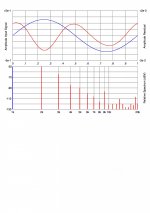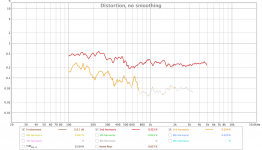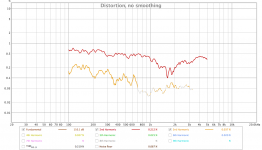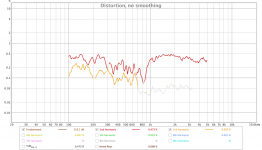I agree! When using LTSpice and viewing the harmonic distortion components the 2nd harmonic will be +45 degrees relative to the fundamental for a perfect neg. phase 2nd harmonic.I've used this method for tuning my F7 approximation and my ears like that setting more than all the others I have tried.
I'm not following your line. Make the fundamental test frequency at output display phase positive relative to the input. Say use 1 KHz to test. Then when measuring, dose the second harmonic have any phase rotation relative to the input? Is it closer to 180 degrees from the fundamental (negative phase) or is it closer to 0 degrees (positive phase)? That sums up my concerns. If both fundamental and second harmonic are negative relative to the input when starting that means to me that they are positive phase between both fundamental and first harmonic and flipping a speaker cable changes nothing between them.
I'm not following your line. Make the fundamental test frequency at output display phase positive relative to the input. Say use 1 KHz to test. Then when measuring, dose the second harmonic have any phase rotation relative to the input? Is it closer to 180 degrees from the fundamental (negative phase) or is it closer to 0 degrees (positive phase)? That sums up my concerns. If both fundamental and second harmonic are negative relative to the input when starting that means to me that they are positive phase between both fundamental and first harmonic and flipping a speaker cable changes nothing between them.
Look at the picture in post #156.This shows neg. phase H2 (lower trace).Look at the fundamental where it crosses the x axis going positive and take that as your reference (0 degrees).Now look directly below that point to the H2 trace.You will see it crosses the x axis ahead ie: + degrees ahead of the fundamental by approx. 90 degrees referenced to the H2 which is +45 degrees referenced to the fundamental.LTSpice shows harmonics referenced to the fundamental,in my sim I use 1khz as the fundamental.So if I see my H2 is +45 degrees that is a perfect neg. phase H2.Nelson explains neg. phase H2 as having a negative peak at the same points along the x axis as the fundamental has its positive and negative peaks.
Hi,the residual (red) has a negative peak when the fundamental has a positive or negative peak. If I understand correctly, this is a 2H negative.
I am looking at the picture in post #161 and I do not see a 45 degree offset.
No there is a little more than 45 degrees but less than 90 degrees,I said perfect is 45 degrees,its still negative phase H2,there is a range.
When I say 45 degrees is perfect I mean the H2 is 45 degrees referenced to the fundamental which is 90 degrees referenced to H2.
Last edited:
Both the Nutube and the H2 can be adjusted for positive or negative
phase H2.
My definition is: Negative peaks on harmonic with any peak of fundamental
equals negative phase. Positive harmonic peaks with any fundamental
peak is positive phase.
And once again, if the circuit is inverting, then the harmonic phase inverts
if you correct the absolute polarity after the distortion generator.

phase H2.
My definition is: Negative peaks on harmonic with any peak of fundamental
equals negative phase. Positive harmonic peaks with any fundamental
peak is positive phase.
And once again, if the circuit is inverting, then the harmonic phase inverts
if you correct the absolute polarity after the distortion generator.

For those who feel left out in the cold, I have completed some artwork
for these projects, and we will try to get cheap kits in the store shortly.

for these projects, and we will try to get cheap kits in the store shortly.

Oreo is simply saying the 0deg start of H2 is at about 45deg part of the input. The green A vertical line is 90deg on the input signal...H2 residual lags the input by 45deg.


Last edited:
H2 dominant will always have 2 complete sine waves to H1's complete cycle. H3 dominant has three...


I don't see 45 degrees
Forget about H2's degrees,look at how much advanced H2's positive going zero crossing is ahead of H1's (using H1's x axis degrees),its about 45 degrees.
Forget about H2's degrees,look at how much advanced H2's positive going zero crossing is ahead of H1's (using H1's x axis degrees),its about 45 degrees.LTspice refers its harmonic phase angle measurements to the degrees of the fundamental.
Some of Nelson's amps produce mostly 3rd harmonic. Is there a preferred phase of H3?
The Amp Camp Amp inverts the signal and produces an in phase H2 at it's output. There is an option to convert a dual channel ACA to single channel bridge drive. The way this is implemented on the DIY Audio store's kits simply uses a resistor to reduce the gain of the 'slave' side to unity. What does feeding + phase H2 to the second channel do to the output? Is H2 canceled or reinforced ?
Isn't there a better way to create bridge drive ? When I measured the ACA's distortion in bridge mode I simply used the balanced output of the AP system.
The Amp Camp Amp inverts the signal and produces an in phase H2 at it's output. There is an option to convert a dual channel ACA to single channel bridge drive. The way this is implemented on the DIY Audio store's kits simply uses a resistor to reduce the gain of the 'slave' side to unity. What does feeding + phase H2 to the second channel do to the output? Is H2 canceled or reinforced ?
Isn't there a better way to create bridge drive ? When I measured the ACA's distortion in bridge mode I simply used the balanced output of the AP system.
Some of Nelson's amps produce mostly 3rd harmonic. Is there a preferred phase of H3?
You almost always see H3 aligned to form slight compression on peaks
of fundamental, for fairly obvious reasons.
Rarely you will see H3 consisting of slight expansion at peaks. One can
speculate that maybe this leads to more dynamic sound.
Amplifier example was the Stasis 1, where at modest power levels the
H2 has expansion characteristic.
Hi,
If I use H2 in-front of chipamp/class d
A)is it mimic like tube amp or SIT
B) with second harmonic character like class A.
Thanks,
Nag.
If I use H2 in-front of chipamp/class d
A)is it mimic like tube amp or SIT
B) with second harmonic character like class A.
Thanks,
Nag.
Hi,
If I use H2 in-front of chipamp/class d
A)is it mimic like tube amp or SIT
B) with second harmonic character like class A.
Thanks,
Nag.
A major part of SET sound signature should be H2, but you may want to limit frequency response as well. Vintage 600:600 line transformer should work well for this. 🙂
You might want to use a transformer for another reason as well:
The H2 circuit is only good to a couple volts output. If you want more,
the transformer could give it to you. also handy for performing phase
inversion so as to correct the phase inversion of the H2 circuit.

The H2 circuit is only good to a couple volts output. If you want more,
the transformer could give it to you. also handy for performing phase
inversion so as to correct the phase inversion of the H2 circuit.

It would be a good idea to measure H2 of the speaker output. It seems like actual H2 we're hearing is heavily and unpredictably affected by the speaker network design, unit H2, and (possibly) time alignment.
Is this another reason why many SET guys love FR?
Showing plot is 2 way BW3 @810Hz, driven by AJ.
No H2 - positive H2 - Negative H2
Is this another reason why many SET guys love FR?
Showing plot is 2 way BW3 @810Hz, driven by AJ.
No H2 - positive H2 - Negative H2
Attachments
Last edited:





